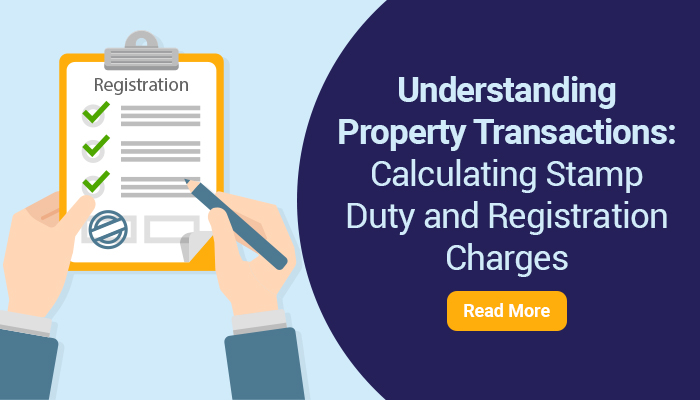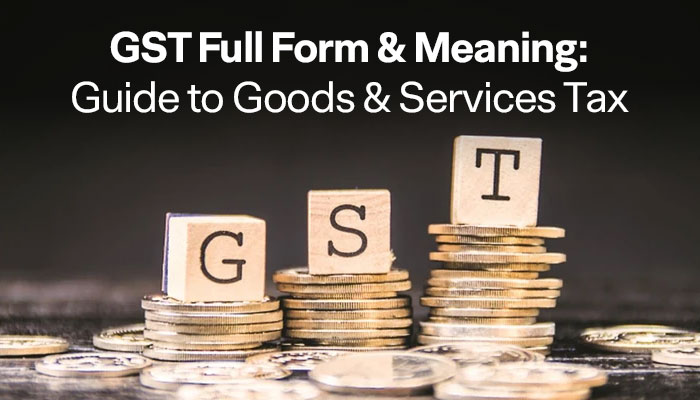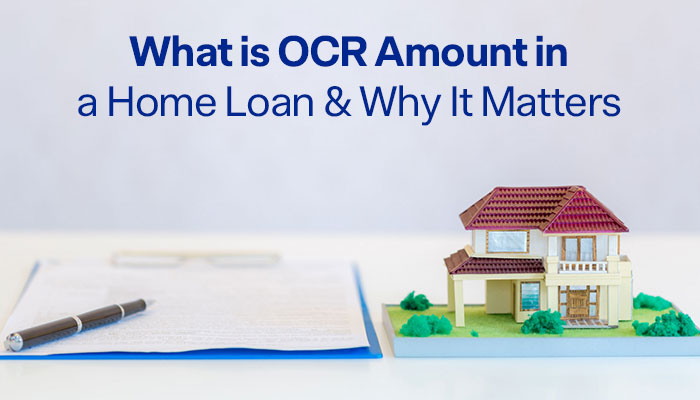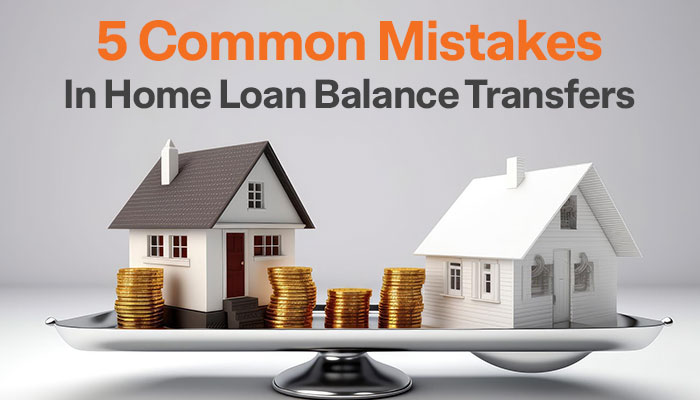How Stamp Duty and Registration Charges are Calculated on Property?

Stamp Duty and Registration Charges aren't fixed values but dynamic variables that shift by property values, locations, and even property types. Being well-versed in this empowers prospective property buyers, offering a comprehensive grasp of the expenses involved.
Stamp duty and registration charges are vital components in the process of property ownership transfer. They serve as legal requirements of the government during property transactions.
Stamp duty is a state government tax levied on property transactions, while registration charges are fees paid to register the property under the buyer's name.
These charges authenticate the transfer of ownership and make the transaction legally valid. Understanding and accounting for stamp duty and registration charges are crucial to ensuring a smooth and legally compliant property transaction.
For a detailed understanding of property financing and tailored solutions, explore the resources available at IIFL Home Loans, ensuring a seamless journey into property ownership.
What are Stamp Duty and Registration Charges?
Stamp duty and registration charges are fees or taxes imposed by the government during the registration of property transactions. These charges are applicable when properties, including land, houses, or commercial spaces, are bought, sold, or transferred.
Stamp Duty
This is a state government tax levied on property transactions. It is calculated based on the property's market value or the agreement value, whichever is higher. Stamp duty is paid by the buyer on the property's sale agreement. The rate of stamp duty varies across states and is usually a percentage of the property's value.

Registration Charges for Flat
Registration Charges
These charges are the fees paid to the government for registering the property under the buyer's name. The registration fee is a fixed charge, and the amount is calculated based on the property's value or the circle rate (minimum value set by the government for properties in a specific area).
Both stamp duty and registration charges are essential legal requirements. Stamp duty is paid on property purchase and transfer and a Registration charge is paid to authenticate the ownership transfer.

How to Find Stamp Duty Value of Property
How are Stamp Duty and Registration Charges Calculated in India?
The calculation of stamp duty and registration charges in India involves a cost typically ranging from 5-7% of the property's market value for stamp duty and approximately 1% for registration charges. These charges, which can amount to lakhs of rupees, are crucial aspects when purchasing and registering a property. Factor in the stamp duty and registration charges when applying for a home loan.
Determining the specific amount of stamp duty involves various factors, such as:
- Property market value
- Property type and the number of floors
- Intended property usage (residential or commercial)
- Property Location
- Age and gender of the property owner
Here's an example of how to calculate stamp duty:
- Circle rate in the area: Rs. 4,000 per sq ft
- Property size: 1000 sq ft
- Property cost according to the circle rate: Rs. 60 lakh
- Stamp duty on House Purchase rate: 6%
- Stamp duty payable: 6 percent of Rs. 60 lakh = Rs. 3,60,000
- Registration charges: 1%
- Registration charges payable: 1 percent of Rs 60 Lakh=60,000

Property Registration Charges Calculator
Payment methods for Stamp Duty
Physical Stamp Paper
Physical stamp paper is a common approach, where authorized sellers provide stamp papers for property documentation. However, if stamp duty costs are high, the purchase of numerous stamp papers can be inconvenient.
Franking
Franking involves a trip to an authorized franking agent who applies a stamp on your property documents, indicating payment of the stamp duty.
E-stamping
E-stamping, the most convenient method, allows online payment of stamp duty via the SHCIL (Stock Holding Corporation of India Ltd.) website. Simply visit the website, choose the state where your property is located, fill out the application form, and submit it to the collection centre along with the required funds.
Documents required for Payment of Stamp Duty and Registration in India
|
Sale Deed or Agreement |
Property Documents (Title deed, possession certificate, etc.) |
|
Identity Proof (Aadhar card, voter ID, etc.) |
Encumbrance Certificate |
|
Address Proof (Utility bills, etc.) |
No Objection Certificate (NOC) |
|
PAN Card |
Payment Receipts |
|
Passport Size Photographs |
Power of Attorney (if applicable) |
Final Takeaways
Understanding the Stamp Duty and Registration Charges is crucial for property buyers. These expenses, varying based on property type, location, and market value, significantly impact the cost of property ownership. Stamp duty, a state government tax, and registration charges, payable to the government for the legal registration of the property, are key in property transactions.
The calculation of Stamp Duty and Registration Charges involves costs ranging from 5-7% of the property's market value for stamp duty and approximately 1% for registration charges. Determining the specific amount involves various factors such as the property's market value, type, usage, location, and the owner's demographics. Methods of payment for stamp duty include physical stamp paper, franking, and e-stamping.
If you are looking for online tools and insights to help you assess Stamp Duty, Registration Charges, and home loan financing, you can check out IIFL Home Loans. They offer a Home Loan Calculator that lets you calculate your home loan EMI. You can also find a Home Buyer Guide that covers how to choose the right property, how to apply for a home loan, and how to manage your finances.
IIFL Home Loans also has a portal where you can check your home loan eligibility online by filling out a simple form. You can read the Customer Testimonials to see how they have helped thousands of customers fulfill their dream of owning a home.
FAQs
Q1. Can stamp duty be claimed as a tax deduction?
Ans. Yes, stamp duty can be claimed as a tax deduction under Section 80C of the Income Tax Act, up to a maximum limit of Rs. 1,50,000.
Q2. Can I get my money back after paying Stamp Duty?
Ans. Stamp duty is generally not refundable. Once paid, it is considered a final cost associated with the property transaction and is non-refundable.
Q3. Does stamp duty include GST?
Ans. Stamp duty is distinct from Goods and Services Tax (GST). It is a state government tax on property transactions and is not levied by the central government. GST may be applicable on the sale of under-construction properties, but it is separate from stamp duty.
Q4. Are stamp duty and registration charges included in a home loan?
Ans. Stamp duty and registration charges are not typically included in the home loan amount sanctioned by the bank. The bank does not include these costs in the home loan amount because they are not part of the value of the property. Borrowers need to arrange for these charges separately when purchasing a property.
Tags
Disclaimer: The information contained in this post is for general information purposes only. IIFL Home Finance Limited (including its associates and affiliates) ("the Company") assumes no liability or responsibility for any errors or omissions in the contents of this post and under no circumstances shall the Company be liable for any damage, loss, injury or disappointment, etc. suffered by any reader. All information in this post is provided "as is", with no guarantee of completeness, accuracy, timeliness, or of the results, etc. obtained from the use of this information, and without warranty of any kind, express or implied, including, but not limited to warranties of performance, merchantability, and fitness for a particular purpose. Given the changing nature of laws, rules, and regulations, there may be delays, omissions, or inaccuracies in the information contained in this post. The information on this post is provided with the understanding that the Company is not herein engaged in rendering legal, accounting, tax, or other professional advice and services. As such, it should not be used as a substitute for consultation with professional accounting, tax, legal or other competent advisers. This post may contain views and opinions which are those of the authors and do not necessarily reflect the official policy or position of any other agency or organization. This post may also contain links to external websites that are not provided or maintained by or in any way affiliated with the Company and the Company does not guarantee the accuracy, relevance, timeliness, or completeness of any information on these external websites. Any/ all (Home/ Loan Against Property/ Secured Business Loan/ Balance Transfer/ Home Improvement Loan/ NRI Home Loan/ Home Loan for Uniformed Services) loan product specifications and information that may be stated in this post are subject to change from time to time, readers are advised to reach out to the Company for current specifications of the said (Home/ Loan Against Property/ Secured Business Loan/ Balance Transfer/ Home Improvement Loan/ NRI Home Loan/ Home Loan for Uniformed Services) loan.
 Login
Login






















